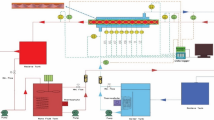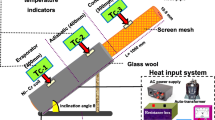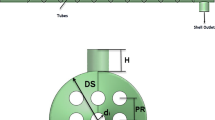Abstract
The present study aims at optimizing the heat transmission parameters such as Nusselt number and friction factor in a small double pipe heat exchanger equipped with rotating spiral tapes cut as triangles and filled with aluminum oxide nanofluid. The effects of Reynolds number, twist ratio (y/w), rotating twisted tape and concentration (w%) on the Nusselt number and friction factor are also investigated. The central composite design and the response surface methodology are used for evaluating the responses necessary for optimization. According to the optimal curves, the most optimized value obtained for Nusselt number and friction factor was 146.6675 and 0.06020, respectively. Finally, an appropriate correlation is also provided to achieve the optimal model of the minimum cost. Optimization results showed that the cost has decreased in the best case.




















Similar content being viewed by others
Abbreviations
- A:
-
Heat transfer area (m2)
- Cp:
-
Specific heat (kJ kg−1 °C−1)
- D:
-
Tube diameter (m)
- d:
-
Nanoparticle diameter (m)
- h:
-
Convective heat transfer coefficient (W m-2oC−1)
- k:
-
Thermal conductivity (W m-1oC−1)
- L:
-
Tube length (m)
- mo :
-
Mass flow rate (kg s−1)
- Nu:
-
Nusselt number (Dimensionless)
- Pe:
-
Peclet number (Dimensionless)
- Pr:
-
Prandtl number (Dimensionless)
- Re:
-
Reynolds number (Dimensionless)
- T:
-
Temperature (°C)
- U:
-
Overall heat transfer coefficient (W m-2oC−1)
- w:
-
Width
- R2 reg :
-
Registered correlation coefficient
- R2 Adj :
-
Adjusted correlation coefficient
- R2 Pred :
-
Predicted correlation coefficient
- F Value:
-
F distribution-a mathematical function
- P value:
-
P distribution -a mathematical function
- w:
-
Weight fraction (%)
- V:
-
Velocity (m2 s−1)
- F:
-
Friction factor
- Nu:
-
Nusselt number
- Δ:
-
Thickness
- ∆P nf :
-
Pressure drop (Pa)
- α :
-
Thermal diffusivity (m2/s)
- ρ :
-
Density (kg m−3)
- ϑ :
-
Kinematic viscosity (m2/s)
- φ V :
-
Nanoparticle volume concentration (%)
- ANOVA:
-
Analysis of variance
- CCD:
-
Central composite design
- CFD:
-
Computational fluid dynamics
- SEM:
-
Scanning electron microscope
- TEM:
-
Transmission electronic microscope
- PRESS:
-
Prediction error of sum of squares
- 3D:
-
Three dimensional
- 2D:
-
two dimensional
- ANN:
-
Artificial neural network
- GPR:
-
Geometrical progression ratio
- RGPR:
-
Reducer geometrical progression ratio
- RSM:
-
Response surface methodology
References
Gunes S, Manay E, Senyigit E, Ozceyhan VA (2001) Taguchi approach for optimization of design parameters in a tube with coiled wire inserts. Appl Thermal Eng 31(14–15):2568–2577
Huai H, Bing X, Hao W, We S (2015) Multi-objective shape optimization of double pipe heat exchanger with inner corrugated tube using RSM method. Int J Therm Sci 90:173–186
Maddah H, Ghasemi N, Keyvani B, Cheraghali R (2017) Experimental and numerical study of nanofluid in heat exchanger fitted by modified twisted tape: exergy analysis and ANN prediction model. Heat Mass Transf 53(4):1413–1423
Maddah H, Ghasemi N (2017) Experimental evaluation of heat transfer efficiency of nanofluid in a double pipe heat exchanger and prediction of experimental results using artificial neural networks. Heat Mass Transf. https://doi.org/10.1007/s00231-017-2068-6
Chamoli S, Yu P, Yu S (2017) Multi-objective shape optimization of a heat exchanger tube fitted with compound inserts. Appl Therm Eng 117:708–724
Milani Shirvan K, Mamourian M, Mirzakhanlari S, Ellahi R (2017) Numerical Investigation of Heat Exchanger Effectiveness in a Double Pipe Heat Exchanger Filled With Nanofluid: A Sensitivity Analysis by Response Surface Methodology. Powder Technol 313:99–111
Esfe MH, Hajmohammad H, Toghraie D, Rostamian H, Mahian O, Wongwises S (2017) Multi-Objective Optimization of Nanofluid Flow in Double Tube Heat Exchangers for Applications in Energy Systems. Energy. https://doi.org/10.1016/j.energy.2017.06.104
Mohammadiun H, Mohammadiun M, Hazbehian M, Maddah H (2016) Experimental study of ethylene glycol-based Al2O3 nanofluid turbulent heat transfer enhancement in the corrugated tube with twisted tapes. Heat Mass Transfer J 52(1):141–151(8)
Eiamsa-ard S, Thianpong C, Eiamsa-ard P, Promvonge P (2010) Thermal characteristics in a heat exchanger tube fitted with dual twisted tape elements in tandem. Int Commun Heat Mass Transf 37:39–46(9)
Myers R (1976) Response surface methodology. Edwards Brothers, Ann Arbor, MI
Milani Shirvan K, Mamourian M, Mirzakhanlari S, Ellahi R (2016) Two phase simulation and sensitivity analysis of effective parameters on combined heat transfer and pressure drop in a solar heat exchanger filled with nanofluid by RSM. J Mol Liq 220:888–901
Author information
Authors and Affiliations
Corresponding author
Appendix: Uncertainty analysis
Appendix: Uncertainty analysis
A systematic error analysis was used to estimate the errors in the experimental analysis. The uncertainties calculated with the maximum possible error for the parameters and various instruments are given in Tables 6 and 7, respectively.
-
(a)
Reynolds number
-
(b)
Heat transfer coefficient
-
(c)
Nusselt number
(d) Friction factor
Rights and permissions
About this article
Cite this article
Ghasemi, N., Aghayari, R. & Maddah, H. Optimizing the parameters of heat transmission in a small heat exchanger with spiral tapes cut as triangles and Aluminum oxide nanofluid using central composite design method. Heat Mass Transfer 54, 2113–2130 (2018). https://doi.org/10.1007/s00231-018-2292-8
Received:
Accepted:
Published:
Issue Date:
DOI: https://doi.org/10.1007/s00231-018-2292-8




